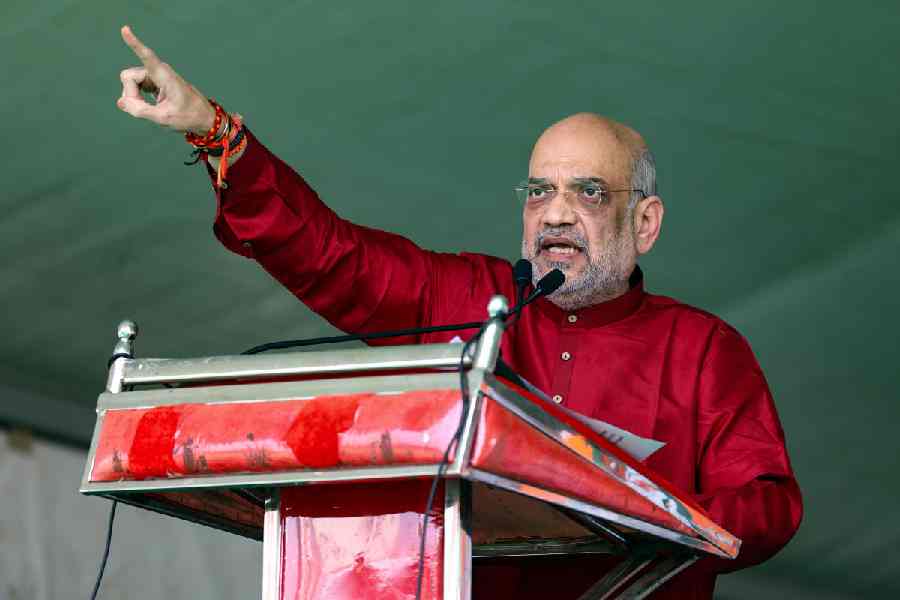Union Home Minister Amit Shah on Thursday said the Centre has decided to scrap the India-Myanmar Free Movement Regime (FMR) to maintain the country's internal security and demographic structure of the northeastern states.
As the Ministry of External Affairs is currently in the process of scrapping it, the Ministry of Home Affairs (MHA) has recommended the immediate suspension of FMR, Shah said.
FMR allows people residing close to the India-Myanmar border to venture 16 km into each other's territory without any documents.
"It is Prime Minister Shri @narendramodi Ji's resolve to secure our borders. The Ministry of Home Affairs (MHA) has decided that the Free Movement Regime (FMR) between India and Myanmar be scrapped to ensure the internal security of the country and to maintain the demographic structure of India's North Eastern States bordering Myanmar," Shah said on X.
The announcement came two days after Shah said India has decided to fence the entire 1,643-km-long India-Myanmar border.
The India-Myanmar border, which passes through Mizoram, Manipur, Nagaland and Arunachal Pradesh, currently has FMR. It was implemented in 2018 as part of India's Act East policy.
Fencing along the border has been a persistent demand of the Imphal valley-based Meitei groups which have been alleging that tribal militants often enter into India through the porous border.
The Meitei groups also allege that narcotics are being smuggled into India taking advantage of the unfenced international border.
On Tuesday, the home minister had said besides constructing a fence along the entire Indo-Myanmar border, a patrol track along the border will also be paved to facilitate better surveillance.
Furthermore, two pilot projects of fencing through a hybrid surveillance system are under execution.
"They will fence a stretch of one km each in Arunachal Pradesh and Manipur. Additionally, fence works covering approx 20 km in Manipur have also been approved, and the work will start soon," he had said.
Manipur shares around 390 kms of porous border with Myanmar, but only about 10 kms has been fenced so far.
In July last year, the state government shared data that around 700 illegal immigrants entered the state.
Besides, Mizoram has seen an influx of anti-Junta rebels in thousands since the military coup in Myanmar on February 1, 2021.
According to government estimates, several thousand refugees are living in different parts of Mizoram since the coup. Mizoram shares a 510-km-long porous border with Myanmar.
Manipur Chief Minister N Biren Singh had also said that several persons from Myanmar tried to enter into his state but returned on seeing the presence of a large number of security personnel.
Apart from Manipur and Mizoram, Arunachal Pradesh shares a 520-km border with Myanmar while Nagaland shares a 215-km border with the country.
On February 3, after meeting Shah, the Manipur chief minister said the Centre is set to take "some important decisions" in the interests of the people of the state.
Manipur has been witnessing sporadic violence. Ethnic violence broke out in Manipur on May 3, 2023 after a tribal solidarity march was organised in the hill districts to protest against the majority Meitei community's demand for Scheduled Tribe status.
Since then over 200 people have been killed in the continuing violence. While a section of Kukis have demanded a separate administration or separation from the Manipur government, the Meitei groups are dead against it and warned legislators against any such design and asked them to foil such attempts.
Meiteis account for about 53 per cent of Manipur's population and live mostly in the Imphal valley, while tribals, which include Nagas and Kukis, constitute 40 per cent and reside mainly in the hill districts. The rest belong to other communities.
A series of confidence building measures were taken and that include constitution of a judicial inquiry committee, financial aids to the victims and sending additional troops.
Shah had visited the state for four consecutive days in his efforts to calm down the warring communities. However, intermittent violence continue.
Except for the headline, this story has not been edited by The Telegraph Online staff and has been published from a syndicated feed.











